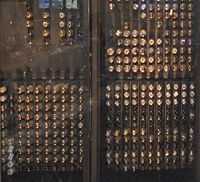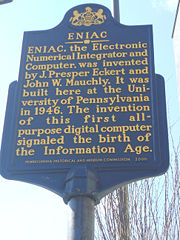ENIAC
From Wikipedia, the free encyclopedia
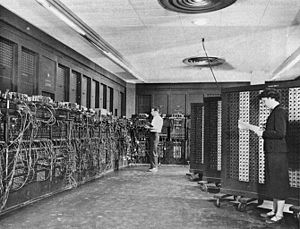
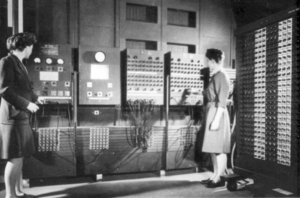
ENIAC, short for Electronic Numerical Integrator And Computer,[1][2] was the first general-purpose electronic computer. It was the first Turing-complete, digital computer capable of being reprogrammed to solve a full range of computing problems,[3] although earlier machines had been built with some of these properties and it could not store a programme. ENIAC was designed and built to calculate artillery firing tables for the U.S. Army's Ballistic Research Laboratory.
The ENIAC held immediate importance. When it was announced in 1946 it was heralded in the press as a "Giant Brain." It boasted speeds one thousand times faster than electro-mechanical machines, a leap in computing power that since then has typically taken fifteen years rather than just three. This mathematical power, coupled with general-purpose programmability, excited scientists and industrialists. The inventors promoted the spread of these new ideas by teaching a series of lectures on computer architecture.
The ENIAC's design and construction were financed by the United States Army during World War II. The construction contract was signed on June 5, 1943, and work on computer was begun in secret by the University of Pennsylvania's Moore School of Electrical Engineering starting the following month under the code name "Project PX". The completed machine was unveiled on February 14, 1946 at the University of Pennsylvania, having cost almost $500,000. ENIAC was shut down on November 9, 1946 for a refurbishment and a memory upgrade, and was transferred to Aberdeen Proving Ground, Maryland in 1947. There, on July 29, 1947, it was turned on and would be in continuous operation until 11:45 p.m. on October 2, 1955.
ENIAC was conceived and designed by John Mauchly and J. Presper Eckert of the University of Pennsylvania.[4] The team of design engineers assisting the development included Bob Shaw (function tables), Chuan Chu (divider/square-rooter), Kite Sharpless (master programmer), Arthur Burks (multiplier), Harry Huskey (reader/printer), Jack Davis (accumulators) and Iredell Eachus Jr.[5]
Contents[hide] |
[edit] Description
The ENIAC was a modular computer, composed of individual panels to perform different functions. Twenty of these modules were accumulators, which could not only add and subtract but hold a ten-digit decimal number in memory. Numbers were passed between these units across a number of general-purpose buses, or trays, as they were called. In order to achieve its high speed, the panels had to send and receive numbers, compute, save the answer, and trigger the next operation — all without any moving parts. Key to its versatility was the ability to branch; It could trigger different operations that depended on the sign of a computed result.
Besides its speed, the most remarkable thing about ENIAC was its size and complexity. ENIAC contained 17,468 vacuum tubes, 7,200 crystal diodes, 1,500 relays, 70,000 resistors, 10,000 capacitors and around 5 million hand-soldered joints. It weighed 30 short tons (27 t), was roughly 8.5 feet by 3 feet by 80 feet (2.6 m by 0.9 m by 26 m), took up 680 square feet (63 m²), and consumed 150 kW of power.[6] Input was possible from an IBM card reader, and an IBM card punch was used for output. These cards could be used to produce printed output offline using an IBM accounting machine, probably the IBM 405.
ENIAC used ten-position ring counters to store digits; each digit used 36 vacuum tubes, 10 of which were the dual triodes making up the flip-flops of the ring counter. Arithmetic was performed by 'counting' pulses with the ring counters and generating carry pulses if the counter 'wrapped around', the idea being to emulate in electronics the operation of the digit wheels of a mechanical adding machine. ENIAC had twenty ten-digit signed accumulators which used ten's complement representation and could perform 5,000 simple addition or subtraction operations between any of them and a source (e.g., another accumulator, or a constant transmitter) every second. (Note: It was possible to connect several accumulators to run simultaneously, so the peak speed of operation was potentially much higher due to parallel operation).
It was possible to wire the carry of one accumulator into another acccumulator to perform double precision arithmetic, but the accumulator carry circuit timing prevented the wiring of three or more for higher precision. The ENIAC used four of the accumulators, controlled by a special Multiplier unit, to perform up to 385 multiplication operations per second. The ENIAC also used five of the accumulators, controlled by a special Divider/Square-Rooter unit, to perform up to forty division operations per second or three square root operations per second.
The other nine units in ENIAC were the Initiating Unit (which started and stopped the machine), the Cycling Unit (used for synchronizing the other units), the Master Programmer (which controlled 'loop' sequencing), the Reader (which controlled an IBM punch card reader), the Printer (which controlled an IBM punch card punch), the Constant Transmitter, and three Function Tables.
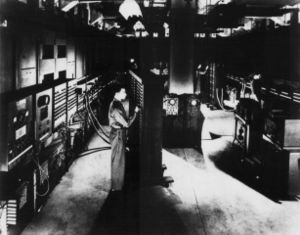
The references by Rojas and Hashagen or (Wilkes 1956)[7] give more details about the times for operations, which differ somewhat from those stated above. The basic machine cycle was 200 microseconds (20 cycles of the 100 kHz clock in the cycling unit), or 5,000 cycles per second for operations on the 10-digit numbers. In one of these cycles, ENIAC could write a number to a register, read a number from a register, or add/subtract two numbers. A multiplication of a 10-digit number by a d-digit number (for d up to 10) took d+4 cycles, so a 10- by 10-digit multiplication took 14 cycles, or 2800 microseconds—a rate of 357 per second. If one of the numbers had fewer than 10 digits, the operation was faster. Division and square roots took 13(d+1) cycles, where d is the number of digits in the result (quotient or square root). So a division or square root took up to 143 cycles, or 28,600 microseconds—a rate of 35 per second. (Wilkes 1956:20[7] states that a division with a 10 digit quotient required 6 milliseconds.) If the result had fewer than ten digits, it was obtained faster.
[edit] Reliability
ENIAC used common octal-base radio tubes of the day; the decimal accumulators were made of 6SN7 flip-flops, while 6L7s, 6SJ7s, 6SA7s and 6AC7s were used in logic functions. Numerous 6L6s and 6V6s served as line drivers to drive pulses through cables between rack assemblies.
Some electronics experts predicted that tube failures would occur so frequently that the machine would never be useful. This prediction turned out to be partially correct: several tubes burned out almost every day, leaving it nonfunctional about half the time. Special high-reliability tubes were not available until 1948. Most of these failures, however, occurred during the warm-up and cool-down periods, when the tube heaters and cathodes were under the most thermal stress. By the simple (if expensive) expedient of never turning the machine off, the engineers reduced ENIAC's tube failures to the more acceptable rate of one tube every two days. According to a 1989 interview with Eckert the continuously failing tubes story was therefore mostly a myth: "We had a tube fail about every two days and we could locate the problem within 15 minutes."
In 1954, the longest continuous period of operation without a failure was 116 hours (close to five days).
[edit] Programmability
The ENIAC could be programmed to perform complex sequences of operations, which could include loops, branches, and subroutines. The task of taking a problem and mapping it onto the machine was quite complex, and usually took weeks. After the program was figured out on paper, the process of getting the program "into" the ENIAC by manipulating its switches and cables took additional days. This was followed by a period of verification and debugging, aided by the ability to "single step" the machine.
The six women who did most of the programming of ENIAC by were inducted in 1997 into the Women in Technology International Hall of Fame.[8][9] As they were called by each other in 1946, they were Kay McNulty, Betty Jennings, Betty Snyder, Marlyn Wescoff, Fran Bilas and Ruth Lichterman.[10][11]
ENIAC was a one-of-a-kind design and was never repeated. The freeze on design in 1943 meant that the computer had a number of shortcomings which were not included in the design, notably the inability to store a program. Eckert and Mauchly started work on a new design, to be later called the EDVAC, which would be both simpler and more powerful. In particular, in 1944 Eckert wrote his description of a memory unit (the mercury delay line) which would hold both the data and the program. John von Neumann, who was consulting for the Moore School on the EDVAC sat in on the Moore School meetings at which the stored program concept was elaborated, wrote up an incomplete set of notes (First Draft of a Report on the EDVAC) intended to be used as an internal memorandum describing, elaborating, and couching in formal logical language the ideas developed in the meetings. Herman Goldstine distributed copies of the First Draft to a number of government and educational institutions, spurring widespread interest in the construction of a new generation of electronic computing machines, including EDSAC and SEAC.
A number of improvements were also made to ENIAC from 1948, including a primitive read-only stored programming mechanism[12] using the Function Tables as program ROM, an idea included in the ENIAC patent and proposed independently by Dr. Richard Clippinger of the BRL. Dick Clippinger consulted with John von Neumann on what instruction set to implement. Clippinger had thought of a 3-address architecture while von Neumann proposed a 1-address architecture because it was simpler to implement. Three digits of one accumulator (6) were used as the program counter, another accumulator (15) was used as the main accumulator, a third accumulator (8) was used as the address pointer for reading data from the function tables, and most of the other accumulators (1-5, 7, 9-14, 17-19) were used for data memory. The programming of the stored program for ENIAC was done by Betty Jennings, Dick Clippinger and Adele Goldstine. It was first demonstrated as a stored-program computer on September 16, 1948, running a program by Adele Goldstine for John von Neumann. This modification reduced the speed of ENIAC by a factor of six and eliminated the ability of parallel computation, but as it also reduced the reprogramming time to hours instead of days, it was considered well worth the loss of performance. Also analysis had shown that due to differences between the electronic speed of computation and the electromechanical speed of input/output, almost any practical real world problem was completely I/O bound even without making use of the original machine's parallelism and most would still be I/O bound even after the speed reduction from this modification. Early in 1952, a high speed shifter was added, which improved the speed for shifting by a factor of five. In July 1953, a 100-word expansion core memory was added to the system, using binary coded decimal, excess-3 number representation. To support this expansion memory, the ENIAC was equipped with a new Function Table selector, a memory address selector, pulse-shaping circuits, and three new orders were added to the programming mechanism.
[edit] Comparison with other early computers
Mechanical and electrical computing machines have been around since the 19th century, but the 1930s and 40s are considered the beginning of the modern computer era.
- The German Z3 (shown working in May 1941) was designed by Konrad Zuse. It was the first general-purpose digital computer, but it was electromechanical, rather than electronic, as it used relays for all functions. It computed logically using binary math. It was programmable by punched tape, but lacked the conditional branch. It was destroyed in a bombing on Berlin in December 1941.
- The American Atanasoff–Berry Computer (ABC) (shown working in summer 1941) was the first electronic computing device. It implemented binary computation with vacuum tubes but was not general purpose, being limited to solving systems of linear equations. It also did not exploit electronic computing speeds, being limited by a rotating capacitor drum memory and an input-output system that was intended to write intermediate results to paper cards. It was manually controlled and was not programmable.
- The British Colossus computers (used for cryptanalysis starting in 1943) were designed by Tommy Flowers. The Colossus computers (of which ten were built) were digital, all-electronic, and could be reprogrammed by rewiring, but they were dedicated to code breaking and not general purpose.[13]
- Howard Aiken's 1944 Harvard Mark I was programmed by punched tape and used relays. It performed general math functions, but lacked any branching.
- The ENIAC was, like the Z3 and Mark I, able to run an arbitrary sequence of mathematical operations, but did not read them from a tape. Like the Colossus, the operations happened at electronic speed. The ENIAC combined full, Turing complete programability with electronic speed.
| Name | First operational | Numeral system | Computing mechanism | Programming | Turing complete |
|---|---|---|---|---|---|
| Zuse Z3 (Germany) | May 1941 | Binary | Electro-mechanical | Program-controlled by punched film stock | Yes (1998) |
| Atanasoff–Berry Computer (US) | Summer 1941 | Binary | Electronic | Not programmable—single purpose | No |
| Colossus (UK) | January 1944 | Binary | Electronic | Program-controlled by patch cables and switches | No |
| Harvard Mark I – IBM ASCC (US) | 1944 | Decimal | Electro-mechanical | Program-controlled by 24-channel punched paper tape (but no conditional branch) | No |
| ENIAC (US) | November 1945 | Decimal | Electronic | Program-controlled by patch cables and switches | Yes |
| Manchester Small-Scale Experimental Machine (UK) | June 1948 | Binary | Electronic | Stored-program in Williams cathode ray tube memory | Yes |
| Modified ENIAC (US) | September 1948 | Decimal | Electronic | Program-controlled by patch cables and switches plus a primitive read-only stored programming mechanism using the Function Tables as program ROM | Yes |
| EDSAC (UK) | May 1949 | Binary | Electronic | Stored-program in mercury delay line memory | Yes |
| Manchester Mark I (UK) | October 1949 | Binary | Electronic | Stored-program in Williams cathode ray tube memory and magnetic drum memory | Yes |
| CSIRAC (Australia) | November 1949 | Binary | Electronic | Stored-program in mercury delay line memory | Yes |
The ABC, ENIAC and Colossus all used thermionic valves (vacuum tubes). ENIAC's registers performed decimal arithmetic, rather than binary arithmetic like the Z3 or the Atanasoff-Berry Computer.
Until 1948, ENIAC required rewiring to reprogram, like the Colossus. The idea of the stored-program computer with combined memory for program and data was conceived during the development of the ENIAC, but it was not implemented at that time because World War II priorities required the machine to be completed quickly, and it was realized that 20 storage locations for memory and programs would be much too small.
[edit] Public knowledge
The Z3 and Colossus were developed independently of each other and independently from the ABC and the ENIAC during World War II. The Z3 was destroyed by Allied bombing of Berlin in 1944. The Colossus machines were part of the UK's war effort, and were destroyed in 1945 to maintain secrecy. Their existence only became generally known in the 1970s, though knowledge of their capabilities remained among their UK staff and invited Americans. The ABC was dismantled by Iowa State University, after John Atanasoff was called to Washington, D.C. to do physics research for the U.S. Navy. ENIAC, by contrast, was put through its paces for the press in 1946, "and captured the world's imagination".[14]
Older histories of computing may therefore not be comprehensive in their coverage and analysis of this period.
[edit] Patent
For a variety of reasons (including Mauchly's June 1941 examination of the Atanasoff–Berry Computer, prototyped in 1939 by John Atanasoff and Clifford Berry), the patent for the ENIAC, granted in 1964, was voided by the 1973 decision of the landmark federal court case Honeywell v. Sperry Rand, putting the invention of the electronic digital computer in the public domain and providing legal recognition to Atanasoff as the inventor of the electronic digital computer.
[edit] Parts on display

The School of Engineering and Applied Science at the University of Pennsylvania has four of the original forty panels and one of the three function tables of the ENIAC. The Smithsonian has five panels in the National Museum of American History in Washington D.C. The Computer History Museum in Mountain View, California has a single panel on display. The University of Michigan in Ann Arbor has four panels, salvaged by Arthur Burks. The U.S. Army Ordnance Museum at Aberdeen Proving Ground, Maryland, where ENIAC was used, has one of the function tables.
As of 2004, a chip of silicon measuring 0.02 inches (0.5 mm) square holds the same capacity as the ENIAC, which occupied a large room.
[edit] See also
- History of computing hardware
- Other early computers:
[edit] Notes
- ^ Goldstine, Herman H. (1972). The Computer: from Pascal to von Neumann. Princeton, New Jersey: Princeton University Press. ISBN 0-691-02367-0.
- ^ "The ENIAC Story". Ftp.arl.mil. Retrieved on 2008-09-22.
- ^ Shurkin, Joel, Engines of the Mind: The Evolution of the Computer from Mainframes to Microprocessors, 1996, ISBN 0-393-31471-5
- ^ Wilkes, M. V. (1956). Automatic Digital Computers. New York: John Wiley & Sons, 305 pages. QA76.W5 1956.
- ^ "Gazette Alumni: Obituaries (Iredell Eachus Jr.)". Retrieved on 2008-09-11. "According to his family, J. Presper Eckert EE’41 GEE’43 Hon’64 was his best friend in college. As a U.S. Naval ensign during World War II, he received a direct commission from President Franklin D. Roosevelt assigning him to naval-research work in Washington, where he was involved in developing technology for weapons systems, radar targeting systems, and communications devices. He then became a member of the ENIAC team at Penn. According to the Main Line Times, he felt that the logic circuits of the machine were more discovered than invented."
- ^ "http://ed-thelen.org/comp-hist/BRL-e-h.html". Retrieved on 2008-05-23.
- ^ a b Wilkes
- ^ "WITI — Hall of Fame".
- ^ "Wired: Women Proto-Programmers Get Their Just Reward".
- ^ "ENIAC Programmers Project".
- ^ "ABC News: First Computer Programmers Inspire Documentary".
- ^ "A Logical Coding System Applied to the ENIAC".
- ^ B. Jack Copeland (editor), Colossus: The Secrets of Bletchley Park's Codebreaking Computers, 2006, Oxford University Press, ISBN 0-19-284055-X.
- ^ Kleiman, Kathryn A. (1997). "WITI Hall of Fame: The ENIAC Programmers". Retrieved on 2007-06-12.
[edit] References
- Goldstine, H. H. and A. Goldstine, The Electronic Numerical Integrator and Computer (ENIAC), 1946 (reprinted in The Origins of Digital Computers: Selected Papers, Springer-Verlag, New York, 1982, pp. 359-373)
- Eckert, J. Presper, The ENIAC (in Nicholas Metropolis, J. Howlett, Gian-Carlo Rota, (editors), A History of Computing in the Twentieth Century, Academic Press, New York, 1980, pp. 525-540)
- Mauchly, John W., The ENIAC (in Metropolis, Nicholas, Jack Howlett, Gian-Carlo Rota, 1980, A History of Computing in the Twentieth Century, Academic Press, New York, ISBN 0124916503, pp. 541-550, "Original versions of these papers were presented at the International Research Conference on the History of Computing, held at the Los Alamos Scientific Laboratory, 10-15 June 1976.")
- Burks, Arthur W. and Alice R. Burks, The ENIAC: The First General-Purpose Electronic Computer (in Annals of the History of Computing, Vol. 3 (No. 4), 1981, pp. 310-389; commentary pp. 389-399)
- W. Barkley Fritz, The Women of ENIAC (in IEEE Annals of the History of Computing, Vol. 18, 1996, pp. 13-28)
- Eckert, J. Presper and John Mauchly, 1946, Outline of plans for development of electronic computers, 6 pages. (The founding document in the electronic computer industry.)
- Raúl Rojas and Ulf Hashagen, editors, The First Computers: History and Architectures, 2000, MIT Press, ISBN 0-262-18197-5.
[edit] Further reading
- Mike Hally, Electronic Brains: Stories from the Dawn of the Computer Age, Joseph Henry Press, 2005. ISBN 0-309-09630-8
- Scott McCartney, ENIAC: The Triumphs and Tragedies of the World's First Computer. Walker & Co, 1999. ISBN 0-8027-1348-3.
- Edmund C. Berkeley, GIANT BRAINS or machines that think. John Wiley & sons, inc., 1949. Chapter 7 Speed—5000 Additions a Second: Moore School's ENIAC (Electronic Numerical Integrator And Computer)
- C.B. Tompkins and J.H Wakelin, High-Speed Computing Devices, McGraw-Hill, 1950.
- Stern, Nancy (1981). From ENIAC to UNIVAC: An Appraisal of the Eckert-Mauchly Computers. Digital Press. ISBN 0-932376-14-2.
- Lukoff, Herman (1979). From Dits to Bits: A personal history of the electronic computer. Portland, Oregon: Robotics Press. ISBN 0-89661-002-0.
[edit] External links
- Oral history interview with J. Presper Eckert Eckert, a co-inventor of the ENIAC, discusses its development at the University of Pennsylvania (1941-46) and the interaction of the personnel at the Moore School. Oral history interview by Nancy B. Stern, 28 October 1977. Charles Babbage Institute
- Oral history interview with Carl Chambers Chambers discusses the initiation and progress of the ENIAC project at the University of Pennsylvania Moore School of Electrical Engineering (1941-46). Oral history interview by Nancy B. Stern, 30 November 1977. Charles Babbage Institute
- Oral history interview with Irven A. Travis Travis describes the ENIAC project at the University of Pennsylvania (1941-46), the technical and leadership abilities of chief engineer J. Presper Eckert, the working relations between Mauchly and Eckert, the disputes over patent rights, and their resignation from the university. Oral history interview by Nancy B. Stern, 21 October 1977. Charles Babbage Institute
- Oral history interview with Frances E. Holberton Holberton describes her work at Eckert-Mauchly Computer Corporation, David Taylor Model Basin, and the National Bureau of Standards, and the difficulties she encountered as a woman. She recounts her work on ENIAC and LARC, her design of operating systems, and her applications programming. Interview by James Baker Ross, 14 April 1983. Charles Babbage Institute
- Mike Muuss: Collected ENIAC documents
- ENIAC chapter in Karl Kempf, Electronic Computers Within The Ordnance Corps, November 1961
- The ENIAC Story, Martin H. Weik, Ordnance Ballistic Research Laboratories, 1961
- ENIAC museum at the University of Pennsylvania
- The women of ENIAC
- ENIAC—monster and marvel 60th anniversary news story
- Interview with Eckert Transcript of a video interview with Eckert by David Allison for the National Museum of American History, Smithsonian Institution on February 2, 1988. An in-depth, technical discussion on the ENIAC, including the thought process behind the design.
- Q&A: A lost interview with ENIAC co-inventor J. Presper Eckert
- ENIAC specifications from Ballistic Research Laboratories Report No. 971 December 1955, (A Survey of Domestic Electronic Digital Computing Systems)
- U.S. Patent 3,120,606 issued in 1964 for ENIAC (TIFF images), also PDF version (18,305 kB, 207 pages)
- How the ENIAC took a Square Root
- ENIAC simulator
- Programming example for the modulo function by Matthieu-P. Schapranow based on the simulation of Till Zoppke (en)
- ENIAC-on-a-Chip
- Programming the ENIAC
